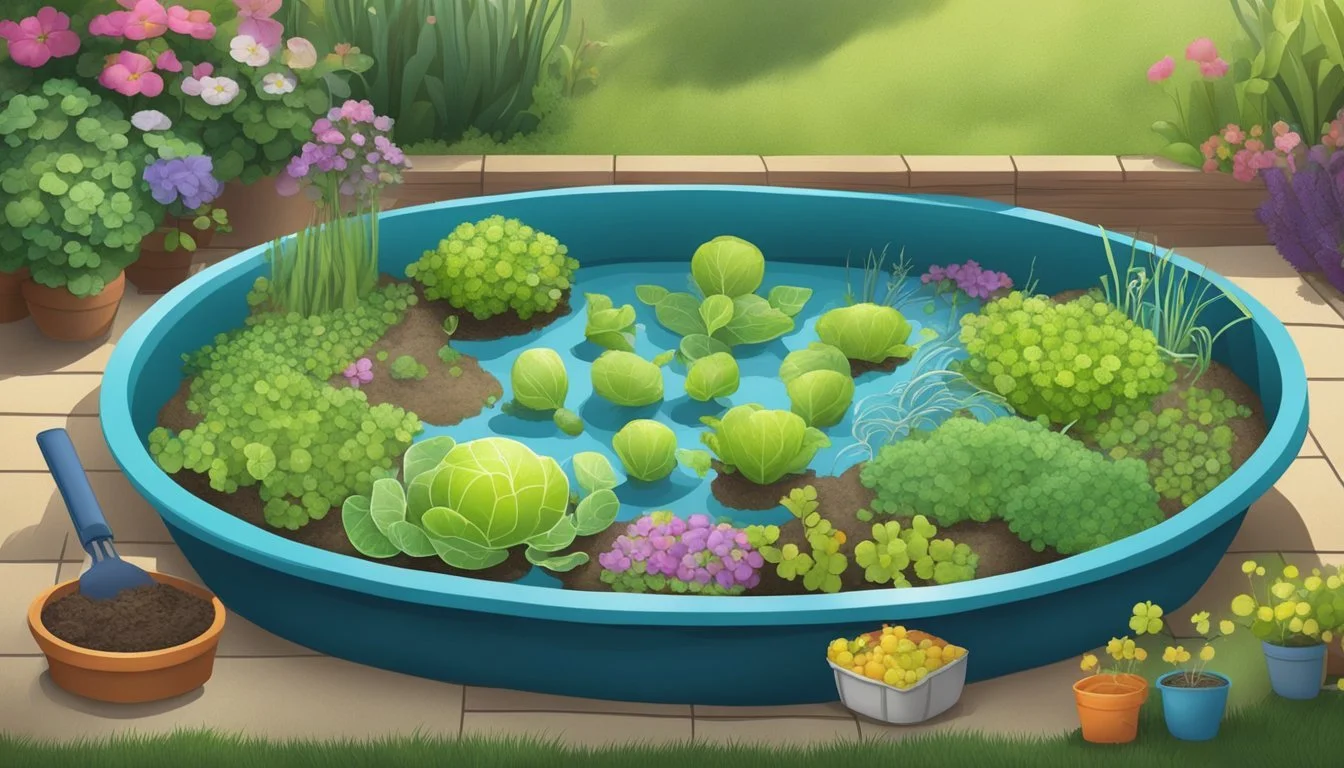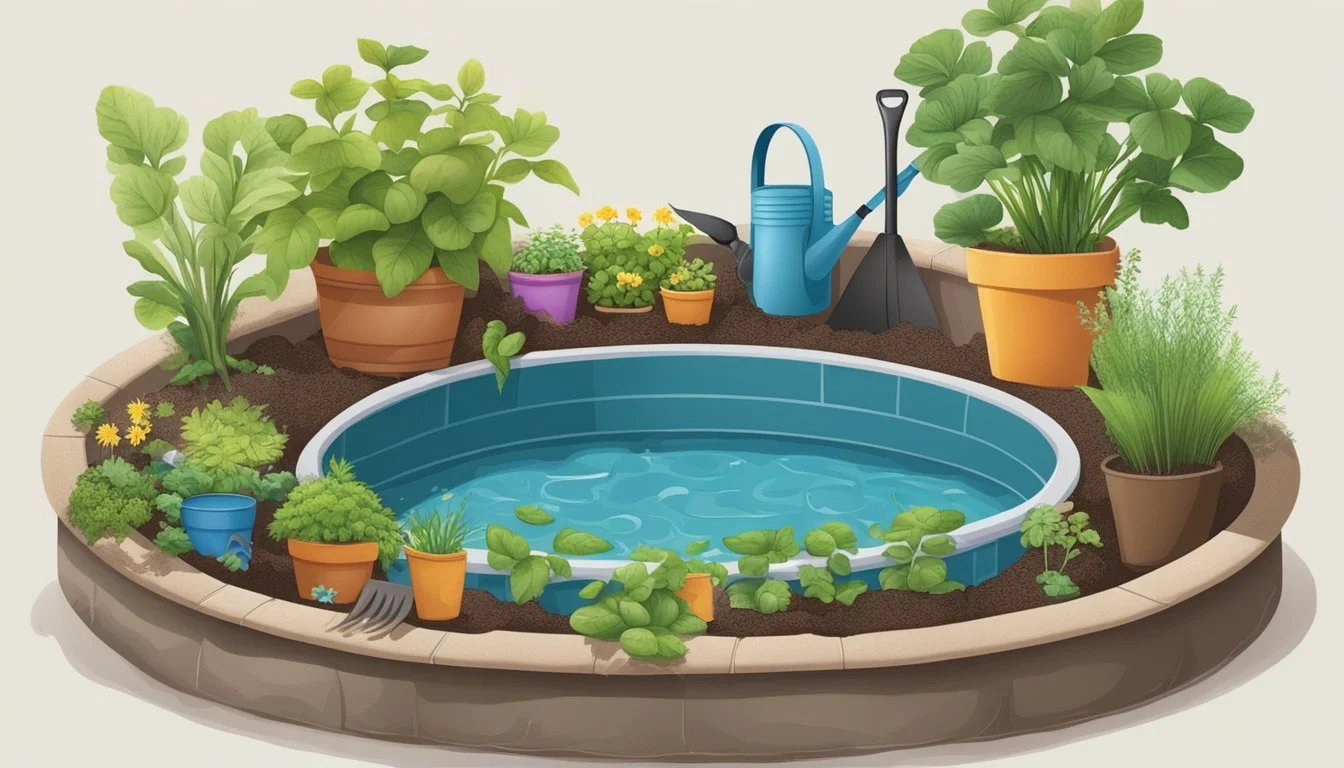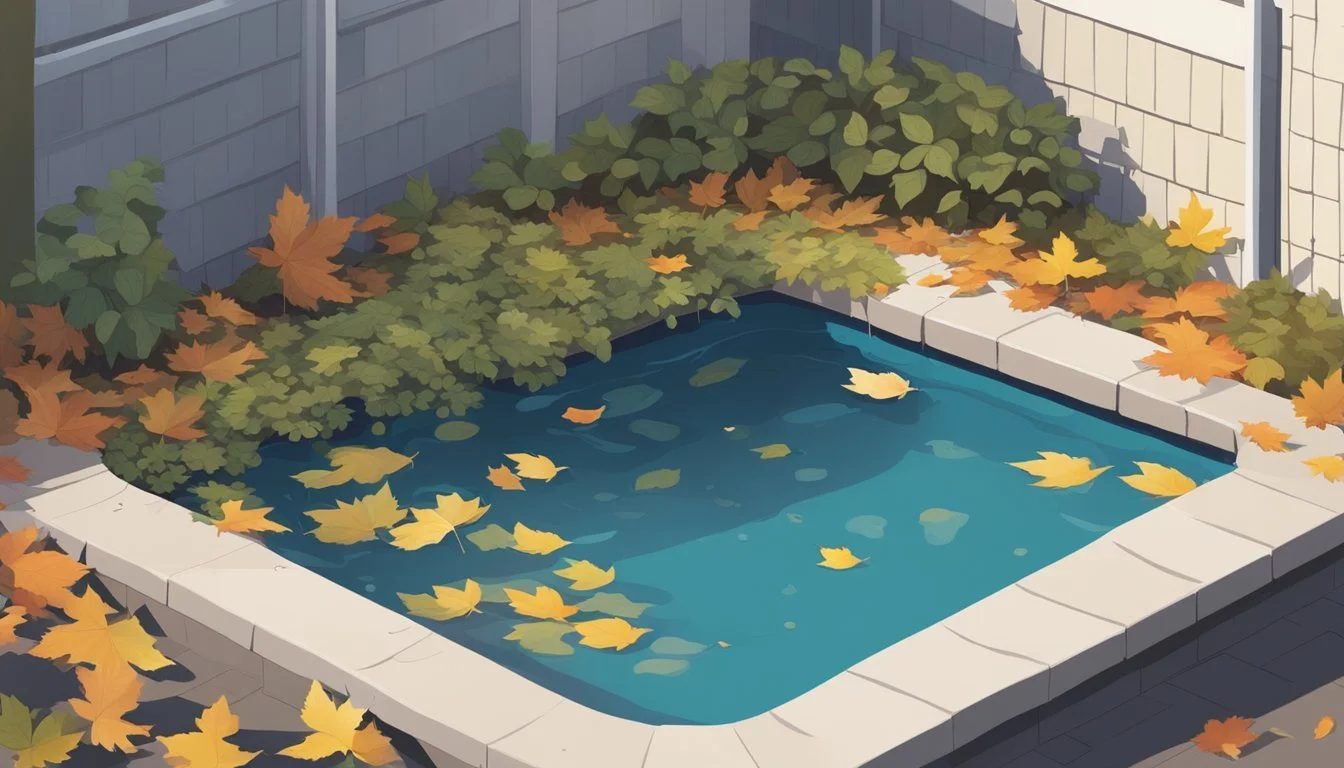Cool Off with Sprouts' Eco-Friendly Kiddie Pool Selection
Essential Summer Cooling for Toddlers
Gardening enthusiasts are always seeking innovative ways to grow their favorite plants, and the sprouts kiddie pool method offers a creative solution. This unconventional approach repurposes a common children's play item into a versatile planting container. By using a kiddie pool as a planter, gardeners can enjoy easy-to-manage raised beds without the need for complex construction.
The sprouts kiddie pool technique is particularly well-suited for growing vegetables and herbs. It provides ample space for root development and allows for good drainage when properly prepared. Gardeners can customize their pool planters by drilling holes in strategic locations, ensuring optimal water flow and preventing waterlogged soil.
This method is especially useful for those with limited garden space or poor soil conditions. The kiddie pool creates a controlled environment where gardeners can easily manage soil quality, moisture levels, and plant nutrition. It's an excellent option for growing shallow-rooted crops like lettuce, radishes, and herbs, as well as deeper-rooted vegetables like tomatoes and peppers when filled with sufficient soil depth.
Understanding Kiddie Pools
Kiddie pools offer a fun and refreshing way for families to enjoy water play at home. These compact pools come in various designs and materials, each with unique features and safety considerations.
Types of Kiddie Pools
Inflatable pools are popular for their portability and easy storage. They typically feature air chambers that can be filled quickly with a pump. Snapset pools have a rigid frame that pops up when filled with water, making setup a breeze.
Plastic kiddie pools are durable and often come in bright colors or fun shapes. These solid structures don't require inflation and can withstand more wear and tear.
Some kiddie pools include built-in features like slides, sprayers, or small play centers, adding extra entertainment value for children.
Material Considerations
PVC and vinyl are common materials for inflatable kiddie pools. They're lightweight, flexible, and resistant to punctures. Many come with repair patches for small tears.
Hard plastic pools are more durable and less prone to damage. They're easier to clean and can handle exposure to sun and chemicals better than inflatable options.
Consider the pool's water capacity when choosing a material. Larger volumes require stronger construction to prevent leaks or structural failure.
Safety and Features
Look for kiddie pools with non-slip bottoms to prevent accidents. Drainage holes or plugs make emptying the pool easier, promoting proper hygiene and preventing stagnant water.
Some pools have multiple air chambers, which can help maintain structure even if one section deflates. This feature enhances safety and longevity.
Check the pool's recommended age range and weight capacity. Ensure adult supervision at all times when children are using the pool. Keep safety equipment nearby and maintain proper water quality to create a safe play environment.
Choosing the Right Location
Selecting an optimal spot for your sprouts kiddie pool garden is crucial for success. The location impacts sunlight exposure, water access, and overall plant health.
Setting Up in Your Backyard
A level area in your backyard is ideal for a sprouts kiddie pool garden. Clear away grass or weeds from the chosen spot. If placing on grass, consider laying a weed barrier underneath to prevent grass growth into the pool.
Gravel or paved surfaces work well too, providing stable footing for the pool. Ensure proper drainage by elevating the pool slightly or drilling small holes in the bottom.
Position the pool near a water source for easy irrigation. A garden hose or watering can should be readily accessible.
Sunlight and Shade Considerations
Most sprouts and vegetables thrive in full sun, requiring 6-8 hours of direct sunlight daily. Observe your yard throughout the day to identify the sunniest spots.
Southern or western exposures typically offer the most sunlight. Avoid areas near large trees or buildings that cast shadows.
Some leafy greens and herbs tolerate partial shade. If full sun isn't available, these plants can still flourish with 4-6 hours of direct light.
During hot summer months, providing afternoon shade can prevent leaf scorch. Use shade cloth or position the pool where it receives morning sun and afternoon shade.
Maintenance and Care
Proper maintenance and care are crucial for extending the life of a sprouts kiddie pool. Regular cleaning, proper storage, and timely repairs ensure a safe and enjoyable swimming experience for children.
Cleaning and Storage
Empty the pool daily to prevent germ growth. Rinse off dirt and debris with fresh water using a garden hose. Scrub the pool's surface with a soft brush to remove body oils and sunscreen residue. Allow the pool to air dry completely before storing or refilling. For deeper cleaning, add a small amount of distilled vinegar to the water before draining. Avoid using chlorine or bleach, as these can damage the pool material.
Store the pool in a cool, dry place when not in use. Deflate inflatable pools fully and fold carefully to prevent creases. Keep the pool away from sharp objects that could puncture it. Consider using a pool cover to protect from debris and sun damage when the pool is set up but not in use.
Repairing and Preserving
Inspect the pool regularly for small holes or tears. Use a repair patch designed for pool materials to fix minor damage promptly. Clean and dry the area around the hole before applying the patch. For inflatable pools, check valves and seams for air leaks. Replace faulty valves if necessary.
To preserve the pool's material, avoid exposing it to excessive sunlight when not in use. UV rays can degrade the pool over time. If possible, set up the pool in a partially shaded area. Use a pool cover or move the pool to a shaded spot when not in use for extended periods. Rinse off chlorine or salt water after use to prevent material breakdown.
Kiddie Pools for Play
Kiddie pools offer a variety of interactive features and water activities to keep children entertained. These pools provide a safe and fun environment for kids to splash, play, and cool off during warm weather.
Interactive Features
Many kiddie pools come equipped with exciting add-ons to enhance playtime. Slides are a popular feature, allowing children to glide into the water with glee. Some inflatable pools include built-in ball pits, combining two favorite activities in one space. Water sprayers create a refreshing mist, adding an element of surprise and delight for young ones.
Certain models incorporate character themes or colorful designs to spark imagination. Pools with raised edges or built-in seats provide comfortable spots for toddlers to rest between play sessions. Durability is key, with many pools using thicker, puncture-resistant materials to withstand active use.
Water Activities for Kids
Kiddie pools enable various engaging water activities for children. Splashing and wading are simple yet enjoyable pastimes that help kids develop motor skills and confidence in water. Parents can introduce floating toys or waterproof books to encourage exploration and learning.
For more structured play, consider games like "treasure hunt" using waterproof objects. Pouring and measuring activities with cups and containers teach basic math concepts while having fun. Supervised water painting on the pool's sides can unleash creativity.
Inflatable pools with different depth levels allow for age-appropriate play areas. Toddlers can safely enjoy shallow sections while older kids use deeper parts for more active games. Always ensure adult supervision during water activities to maintain a safe environment.
Multipurpose Uses of Kiddie Pools
Kiddie pools offer versatile applications beyond summer splashing. They can be repurposed as creative gardening solutions, providing an accessible and affordable way to grow plants in limited spaces.
Kiddie Pool Gardening
Kiddie pools make excellent containers for small-scale gardening. They provide ample space for growing vegetables, flowers, and herbs. The plastic material retains moisture and heat, creating a favorable environment for plant growth.
To set up a kiddie pool garden, drill drainage holes in the bottom and sides. This prevents waterlogging and ensures proper soil aeration. Fill the pool with a mixture of high-quality potting soil and compost.
Choose plants suited for container gardening, such as tomatoes, peppers, lettuce, and herbs. Space them according to their mature sizes. Add a layer of mulch to help retain moisture and suppress weed growth.
Setting up a Small Pool Garden
Select a sunny location for your kiddie pool garden. Ensure it receives at least 6-8 hours of direct sunlight daily. Place the pool on a level surface to prevent water runoff.
Add a layer of gravel or small rocks at the bottom to improve drainage. Fill the pool with a well-draining potting mix enriched with organic matter. Avoid using regular garden soil, as it can become compacted in containers.
Plant seedlings or sow seeds directly into the soil. Water thoroughly after planting. Monitor soil moisture regularly, as container gardens dry out faster than in-ground beds. Fertilize plants every 2-3 weeks with a balanced liquid fertilizer.
Kiddie Pool Gardening Guide
Kiddie pool gardens offer an easy and accessible way to grow vegetables, herbs, and flowers in small spaces. This innovative gardening method provides excellent drainage, portability, and customization options for urban or novice gardeners.
Choosing Soil and Plants
Select a well-draining soil mix for your kiddie pool garden. Combine equal parts potting soil, peat moss, and perlite or vermiculite. This mixture ensures proper aeration and moisture retention for plant roots.
Choose plants that thrive in containers and have similar water and sunlight needs. Leafy greens, herbs, tomatoes, peppers, and cucumbers are excellent options for kiddie pool gardens.
Consider the mature size of plants when planning your layout. Space larger plants like tomatoes and zucchini towards the center, with smaller herbs and lettuce around the edges.
Planting and Maintenance
Drill drainage holes in the bottom and sides of the pool, spaced about 12 inches apart. This prevents waterlogging and root rot.
Fill the pool with your prepared soil mix, leaving 2-3 inches of space at the top. Plant your chosen vegetables, herbs, or flowers according to the instructions on their seed packets.
Water thoroughly after planting. Maintain consistent moisture levels by watering when the top inch of soil feels dry. Apply a balanced, water-soluble fertilizer every 2-3 weeks during the growing season.
Monitor for pests and diseases regularly. Use organic pesticides if needed, or remove affected plants promptly to prevent spread.
Advantages of Pool Gardens
Kiddie pool gardens are highly portable, allowing you to move them to optimal sunlight positions throughout the day. This flexibility is especially useful for balconies or small yards with limited sunny spots.
The raised design of pool gardens reduces strain on your back and knees during planting and maintenance. It also helps deter pests like slugs and snails.
Pool gardens require less water than traditional in-ground gardens due to their contained nature. This makes them an eco-friendly choice for water conservation.
The affordable cost and simple setup of kiddie pool gardens make them ideal for beginners or those with limited space. They provide a low-risk way to experiment with different plants and growing techniques.
Troubleshooting Common Issues
Growing sprouts in a kiddie pool can present unique challenges. Proper management of water, pest control, and optimal growth conditions are essential for success.
Dealing with Water Problems
Adequate drainage is crucial for sprout health. Drill drainage holes in the kiddie pool to prevent waterlogging. Use a gentle spray when watering to avoid damaging delicate sprouts. Rainwater is ideal for irrigation, but tap water works if allowed to sit for 24 hours to dissipate chlorine.
Overwatering can lead to root rot. Monitor soil moisture carefully. Allow the top layer to dry out between waterings. If sprouts show signs of yellowing or wilting, reduce watering frequency.
For improved drainage, add a layer of pebbles or gravel at the bottom of the pool. This helps excess water flow away from roots more efficiently.
Protection Against Pests
Pests can quickly decimate a sprout crop. Cover the kiddie pool with fiberglass window screening or fine mesh to keep insects at bay. Secure the edges tightly to prevent entry points.
For larger pests like birds or rodents, consider using wire fencing or landscape fabric. These materials allow light and air to penetrate while keeping unwanted visitors out.
Regularly inspect sprouts for signs of pest damage. Remove affected plants promptly to prevent spread. Natural deterrents like neem oil or diatomaceous earth can be effective against common pests.
Optimizing Plant Growth
Sprouts thrive in specific conditions. Ensure they receive adequate light - about 4-6 hours of indirect sunlight daily. Too much direct sun can scorch delicate leaves.
Temperature control is vital. Most sprouts prefer cooler conditions. In hot weather, move the kiddie pool to a shaded area or use shade cloth to prevent overheating.
Monitor germination rates closely. If seeds aren't sprouting, check soil temperature and moisture levels. Some varieties may need pre-soaking to encourage faster germination.
For sprouts grown in arid conditions, maintain higher humidity levels. Mist plants regularly or place a tray of water near the kiddie pool to increase ambient moisture.
Accessorizing Your Kiddie Pool
Enhancing your kiddie pool with accessories can improve both its functionality and enjoyment. The right additions can boost safety, comfort, and even transform it into a productive garden space.
Fun and Safety Accessories
A filter is essential for maintaining clean water in your kiddie pool. It removes debris and helps prevent algae growth. Choose a filter appropriate for your pool's water capacity. Inflatable pools typically hold 1000-3000 gallons.
Safety should be a top priority. Install a pool fence or safety cover when not in use. Non-slip mats inside and around the pool prevent accidents. For beach days, consider a Snapset pool with built-in sunshade.
Add comfort with pool cushions or floating loungers. Waterproof speakers bring music to your aquatic oasis. LED lights create a magical atmosphere for evening swims.
Pool Enhancements for Gardening
Transform your kiddie pool into a thriving garden. Drill drainage holes in the bottom and sides for proper water flow. Line the pool with landscape fabric to prevent soil loss.
Fill the pool with a mix of potting soil, compost, and perlite for optimal drainage and nutrition. This soil blend supports a wide variety of plants. Add a slow-release fertilizer to nourish your crops throughout the growing season.
Create a mini irrigation system by installing a soaker hose. This ensures even water distribution. Add a trellis for climbing plants like beans or cucumbers. Use pool noodles to create raised bed dividers for different plant types.
Practical Tips for Parents
Kiddie pools offer a fun and educational opportunity for families to combine water play with gardening. Parents can create a safe and enriching environment that encourages both outdoor enjoyment and learning about plant growth.
Setting Up a Kiddie Pool Safely
Choose a flat, level surface for your kiddie pool. Remove any sharp objects or debris from the area. Opt for a small plastic or inflatable kiddie pool that's easy to set up and maintain. Fill the pool with clean water to a depth of 3-4 inches.
Supervise children at all times when near the pool. Establish clear safety rules, such as no running or pushing. Empty and clean the pool after each use to prevent algae growth and insect breeding. Store the pool upside down when not in use to avoid collecting rainwater.
Consider using a pool cover to keep out debris and curious animals. Regularly inspect the pool for any damage or wear. Replace it if you notice any tears or weak spots.
Engaging Kids in Pool Gardening
Transform your kiddie pool into a mini garden. Line the bottom with landscape fabric and fill it with potting soil. Choose shallow-rooted vegetables like lettuce, radishes, or herbs for quick results.
Let kids wear garden gloves and use a small trowel to plant seeds or seedlings. Carrots and strawberries are fun options that children enjoy growing and eating. Create furrows in the soil and show kids how to space seeds properly.
Encourage daily involvement by having children water the plants gently. Teach them to check soil moisture and look for plant growth. As plants mature, let kids harvest their own produce. This hands-on experience fosters a connection to nature and healthy eating habits.
Use the pool garden to discuss plant life cycles, nutrition, and environmental care. Consider theme gardens like a pizza garden with tomatoes, basil, and oregano to make learning even more engaging.
End of Season Considerations
As summer winds down, proper care for your sprouts kiddie pool ensures longevity and sets the stage for next year's fun. Taking time to reflect on the season's highlights creates lasting memories.
Disassembling and Winterizing
Drain the kiddie pool completely using the built-in drain plug or by tipping it over. Clean the pool thoroughly with mild soap and water, scrubbing away any algae or debris. Allow it to dry fully in the sun to prevent mold growth.
For inflatable pools, deflate them entirely. Check for any small punctures or weak spots and repair if needed. Fold the pool neatly, avoiding sharp creases that could weaken the material.
Store the pool in a cool, dry place away from direct sunlight. A storage bag or plastic container protects it from dust and pests. Keep it elevated off the ground to prevent moisture damage.
Recapping the Season
Take a moment to reflect on the joy your sprouts kiddie pool brought this summer. Consider creating a photo album or scrapbook to preserve backyard memories.
Note which activities were most popular. Did water toys enhance the experience? Was the pool size adequate for your needs? Use these insights to plan for next year.
Evaluate the pool's condition. Did it hold up well or require frequent repairs? This information guides future purchasing decisions.
Create a list of highlights:
Favorite pool games
Coolest water toys
Most memorable pool parties
These reflections help maximize enjoyment for seasons to come.











